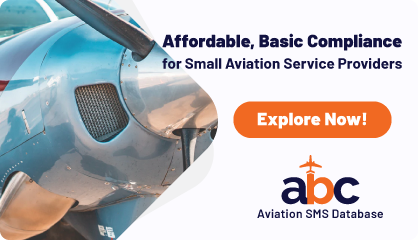The Power of KPIs in Aviation SMS

In aviation, safety is paramount, and a robust Safety Management System (SMS) is the backbone of any successful operation. Without safety considerations, clients would quickly lose confidence in the world's aviation transportation system. An aviation SMS helps maintain consumer confidence.
But how do you measure the effectiveness of your SMS? Enter Key Performance Indicators (KPIs)—data-driven metrics that provide insights into your safety program’s strengths and areas for improvement.
In this article, we’ll explore the role of KPIs in aviation SMS, share practical examples, and show how SMS Pro’s tools can help you track and optimize safety performance.
Related Aviation KPI Articles
- What Is a Key Performance Indicator (KPI) in Aviation SMS? - With Free KPI Resources
- 6 Sources for Aviation Key Performance Indicators - With Free KPI Resources
- Signs of Good KPIs in Aviation SMS
What Are KPIs in Aviation SMS?
KPIs are quantifiable metrics used to evaluate the success of your SMS in meeting safety objectives. They track critical areas like hazard reporting, incident resolution, audit performance, and safety culture engagement. By monitoring KPIs, aviation operators—whether airlines, flight schools, or maintenance organizations—can identify trends, allocate resources effectively, and ensure compliance with regulations like FAA Part 5 and ICAO Annex 19.
Why KPIs Matter for Aviation Safety
KPIs transform raw data into actionable insights, enabling proactive safety management. Here’s why they’re essential:
-
Identify Risks Early: KPIs like hazard report submission rates reveal whether employees are actively identifying risks.
-
Measure Compliance: Audit completion rates ensure your SMS meets regulatory standards.
-
Drive Accountability: Training completion KPIs hold teams accountable for safety education.
-
Enhance Decision-Making: Data trends guide resource allocation, such as prioritizing high-risk areas.
Top KPIs to Monitor in Your Aviation SMS

Here are five critical KPIs to track, along with how SMS Pro simplifies the process:
1. Hazard Report Submission Rate
What It Measures: The number of hazard reports submitted by employees per month or year.
Why It Matters: A high submission rate indicates a strong safety culture where employees feel empowered to report risks.
SMS Pro Solution: SMS Pro’s user-friendly reporting tools encourages submissions and routes reports to safety managers instantly for analysis.
2. Incident Resolution Time
What It Measures: The average time to resolve reported incidents or hazards.
Why It Matters: Faster resolutions reduce risk exposure and demonstrate effective SMS processes.
SMS Pro Solution: Automated workflows in SMS Pro track resolution progress, sending reminders to ensure timely action.
3. Audit Completion Rate
What It Measures: The percentage of scheduled SMS audits completed on time.
Why It Matters: Timely audits ensure compliance and identify gaps in safety processes.
SMS Pro Solution: SMS Pro’s audit management module schedules, tracks, and documents audits, generating audit-ready reports effortlessly.
4. Training Completion Rate
What It Measures: The percentage of employees completing mandatory SMS training.
Why It Matters: Well-trained teams are better equipped to maintain safety standards.
SMS Pro Solution: SMS Pro’s training module delivers interactive courses and tracks completion, ensuring regulatory compliance.
5. Safety Culture Engagement Score
What It Measures: Employee participation in safety surveys or feedback programs.
Why It Matters: High engagement reflects a proactive safety culture, a cornerstone of SMS success.
SMS Pro Solution: SMS Pro’s survey tools collect anonymous feedback, providing insights into cultural strengths and weaknesses.
How to Set and Track KPIs with SMS Pro
Implementing KPIs effectively requires a structured approach. Here’s how SMS Pro helps:
-
Define Clear Objectives: Align KPIs with your safety goals, such as reducing incidents by 10% annually.
-
Leverage Automation: SMS Pro’s dashboards aggregate data from reports, audits, and training, updating KPIs in real time.
-
Visualize Trends: Interactive charts highlight patterns, making it easy to spot risks or successes.
-
Act on Insights: SMS Pro’s actionable reports guide corrective actions, ensuring continuous improvement.
For example, a regional airline using SMS Pro noticed a low hazard report submission rate. By analyzing KPI data, they identified training gaps and launched a targeted campaign, increasing reports by 25% in three months.
Getting Started with KPIs
Ready to harness the power of KPIs? Follow these steps:
-
Assess Your Needs: Identify safety priorities, such as improving reporting or audit efficiency.
-
Choose Relevant KPIs: Start with the five KPIs above or customize metrics for your operation.
-
Use SMS Pro: Leverage SMS Pro’s tools to automate tracking and gain real-time insights.
-
Review Regularly: Analyze KPI trends monthly to ensure your SMS evolves with your needs.
Investing in KPIs isn’t just about numbers—it’s about building a safer, more compliant aviation operation. With SMS Pro, you have a partner to make data-driven safety a reality.
Related Blog Posts Regarding Aviation SMS KPIs
Explore more on KPIs to enhance your aviation SMS:
-
How to Automate KPI Monitoring in Aviation SMS – Streamline KPI tracking with SMS Pro’s automation tools for real-time insights.
-
Choosing Key Performance Indicators in Aviation SMS – Learn how to choose KPIs to drive proactive risk management in aviation SMS.
-
Top 5 KPI Dashboards for Aviation SMS Success – Discover SMS Pro’s dashboards for visualizing KPI trends effectively.
Conclusion
KPIs are the compass guiding your aviation SMS toward success. By tracking metrics like hazard reporting, incident resolution, and training completion, you can proactively manage risks and ensure compliance. SMS Pro’s intuitive tools make KPI monitoring seamless, empowering you to build a safer future. Visit asms-pro.com to learn more.
Ready to track your KPIs? Request a demo today and see SMS Pro in action!
Last Updated May 2025







